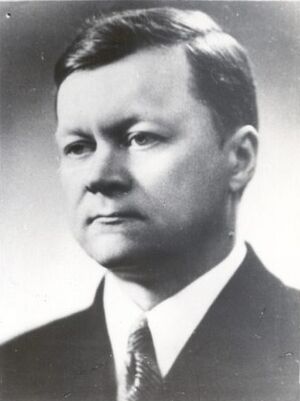Armin Öpik facts for kids
Quick facts for kids
Armin Öpik
|
|
|---|---|

Armin Öpik, during 1930s
|
|
| Born | 24 June 1898 Lontova (now in Kunda), Estonia, Russian Empire
|
| Died | 15 January 1983 (aged 84) |
| Nationality | Estonian and Australian (as of 1955) |
| Alma mater | Estonian State University at Tartu |
| Scientific career | |
| Fields | paleontology |
| Institutions | University of Tartu Geological Museum, Tartu |
| Doctoral advisor | Hendrik Bekker |
Armin Aleksander Öpik (born June 24, 1898, in Kunda, Estonia – died January 15, 1983, in Canberra, Australia) was an Estonian paleontologist. A paleontologist is a scientist who studies fossils to learn about ancient life.
He spent the second half of his career, starting in 1948, working at the Bureau of Mineral Resources in Australia. He is best known for his important work on the Cambrian and Lower Ordovician periods. These are very old time periods in Earth's history. He studied the rock layers (called stratigraphy) and the fossils (called paleontology) found in northern Australia from these times.
Early Life and Family
Armin Öpik was born in a village called Lontova. Today, Lontova is part of Kunda in Estonia. His father, Karl Heinrich Öpik, was a harbormaster. His mother was Leontine Johanna Öpik.
Armin had five brothers and one sister. His oldest brother, Paul Öpik, later became a director of the Bank of Estonia. Paul was the one who first introduced Armin to the exciting world of fossils.
His sister Anna was a philologist, which means she studied languages. She was very talented and could speak 14 languages, including Sanskrit! His brother Oskar became a diplomat, working for his country. Another brother, Ernst, became a very famous astronomer, studying stars and space.
During the First World War, Armin met Barbara Potaschko. They later married and had one son and three daughters. Barbara passed away in Canberra in 1977.
Studies and Work in Estonia
Armin Öpik was a bright student. He graduated from the Nicolai Gymnasium with excellent grades in 1917. He then went on to study geology and mineralogy at the Estonian State University at Tartu.
After his studies, he became a lecturer in geology and mineralogy at the university from 1929 to 1930. In 1930, he became a professor of geology and paleontology. He also became the director of the Geological Institute and Museum at the university, a position he held until 1944.
While in Estonia, Öpik published many papers. He wrote about how rock layers matched up (stratigraphic correlation). He also studied how different environments affected rock formation (facies distribution) and ancient geography (paleogeography). He also looked at how fossils were preserved (biostratonomy) during the Cambrian and lower Ordovician periods in Estonia.
He spent a lot of time studying ancient sea creatures called brachiopods from the Ordovician period. He published detailed books (monographies) about different types of these creatures. He also wrote papers about tiny crustaceans called ostracodes. In 1937, he completed a major book titled Trilobiten aus Estland, which means Trilobites of Estonia.
In 1944, during the Second World War, the Russian army was threatening Estonia. To keep his family safe, Öpik fled his home country. He lived in camps for displaced people in Germany until 1948. That year, he moved to Australia.
Work in Australia
When Armin Öpik arrived in Australia in 1948, he received help from other scientists like C. Teichert and H. Raggatt. Mr. Raggatt was the director of a new organization called the Bureau of Mineral Resources. They helped Öpik get a job at the Bureau's office in Melbourne.
The next year, in 1949, he moved to Canberra. There, he began studying the rock layers (stratigraphy) of the Australian Capital Territory. He focused on rocks from the Ordovician to the Devonian periods.
From 1952 to 1982, Öpik published 27 important works on Cambrian stratigraphy and paleontology. He described many new types of fossils. He identified 94 new groups (genera) and 294 new kinds (species) of Cambrian trilobites. Trilobites were ancient sea creatures with hard shells. He also studied a special group of trilobites called agnostid trilobites.
His important contributions to science were recognized in 1962. He became a fellow of the Australian Academy of Science. This is a high honor for scientists in Australia.
Named in His Honor
Armin Öpik's work was so important that a type of ancient sea creature was named after him. The Silurian crinoid genus Oepikicrinus was named in his honor in 2019. Crinoids are marine animals that look a bit like plants, sometimes called "sea lilies."

